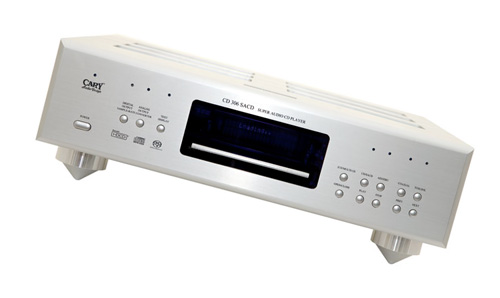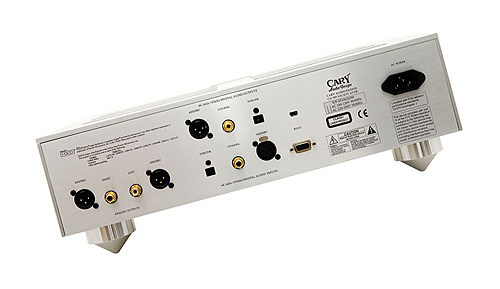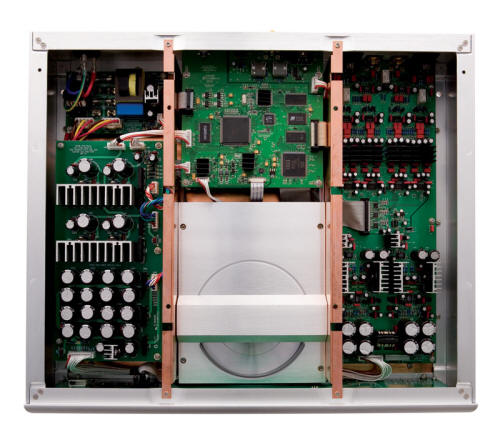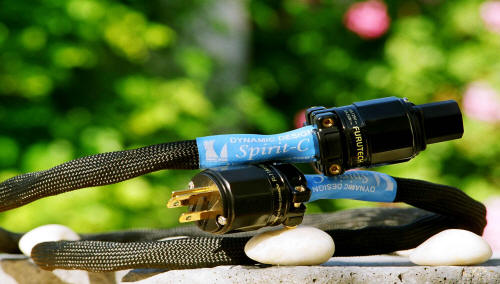
You are reading the older HTML site
Positive Feedback ISSUE
july/august 2008
cary audio
306 Professional SACD player
as reviewed by Dave Clark

|
The Cary 306 has received much praise as one of the better SACD/CD players available for under $10k, not only in these pages, but elsewhere in the world of audio. And rightly so. Simply put, the Cary 306 is a stellar machine that offers the end-user a plethora of options and a sound that is musical, transparent, linear, and well …as non-digitally fatiguing as all get out. Yeah, it does give up a few things to the competition in terms of ultimate slam and transparency (the EMM edges it here in both areas, but then gives up a bit in other important areas like overall musicality), but the Cary has always offered such a grain-free presentation that rivaled the best of the best in terms of being more analog-like than digital-like.
So what does Cary do? They go back to the drawing board and re-think a few things in terms of the player's overall circuit design and layout to not only address heat issues, but how they can wring out just that much more musical bliss without breaking the bank or breaking the mold. Out of this comes the Cary 306 Professional that, at first glance, resembles the original 306 down to the last freckle.
Well, they do have some visual differences, so that one can tell the two apart. The most obvious difference is the 306 Professional's sculpted vented lid, as opposed to the older version's circular glass cut-out that allowed one to view the spinning disc and internal bubble level. A cool visual feature for sure, but once the player is leveled in a rack (you can always use your own small spirit level to the same effect) one is simply not going to enjoy its benefits. Besides the older player was notorious for running hot (the 306 features an analog output stage that runs in Class A—so gee what does one expect as this is an easy source of the player's copious amount of generated heat). The switch to the vented lid allows the newer player to expel heat and run that much cooler—and to a great extent with that much more stability.

Another external difference is that on the player's rear the digital inputs and outputs have been reversed. The newer player has its digital inputs on the bottom and the digital outputs on the top—the older player had these in the reverse. Ah… does this suggest that internally the newer player has seen some changes then as well? Yes, most definitely.
Cary decided to re-layout the circuit boards to allow for more space and cooling for various key components (hence the swapping of the in and outs). Additionally the power supply was dramatically re-done by raising the capacitance from 37,600uF to 63,000uF (now featuring 24 capacitors in total). This was done to not only reduce its output to the lowest possible—practical—impedance, but to provide a more stable and robust supply to the analog and digital circuits (key here is the Master Clock) which are all independent from each other.

The newer 306

The older 306
Other changes included the upsampling of the DSD Master Clock from 11.2896MHz to 22.5792MHz to address SACD resolution and substitution of all the aluminum electrolytic capacitors on the Servo board to Tantalum solid electrolytic capacitors. This allows the board to remain rock-solid regardless of the high temperatures inside the player, something that in the older player could result in an occasional hang-up when accessing a CD or track.
But while the basic overall design remains relatively the same …the player still features 8 Burr Brown 1792u DAC chips running in a true balanced parallel configuration and yes it still does HDCD …the PMD-200 filter has been replaced with a high quality Burr Brown DF-1706 filter chipset. HDCD decoding is now accomplished via software. This was done to address any possible limitations the PMD-200 filter might have had on the digital stream.
The player still allows for upsampling (44.1, 96, 192, 384, 512 or 768kHz sample rates for CD playback to the analog audio outputs, 44.1, 96 or 192kHz Fs for digital inputs—of which are either AES/EBU, Toslink, and S/PDIF), and you get a better remote.
The newer 306 still benefits from an extended break-in (say at least 300 hours) to sound its best and still runs a bit warm to the touch. But once set-up on an appropriate shelf (the 306 still excels on a Townshend 3D sink with some sort of rubber grommets between the tips of the player's four aluminum cones and the Sink's surface), what separates it from the older 306 is that any sense of digital grain or grit are gone. This player is smooth and clean, very, very smooth and clean. While the older 306 had a beautiful sense of what makes analog so special, the latest Professional version just gets it so scary close that well… why bother? Meaning that while very good analog is still very good, very good digital through the Cary is so good that choosing one over the other is now more an issue of convenience than that of superiority.
Of course by saying that the player is smooth might lead one to think that the player is dull or lifeless and lacks sparkle and details. Yeah, some smooth players are simply too smooth and sounds tend to sound a bit dull or rolled off, but not the Cary 306 Professional. The player is extended and tonally linear, and transparently neutral, it just tosses grain and any sense of harshness to the side—unless of course the disc is inherently that way. In that case what you got is what it gives. The Professional, like the older 306, is quite honest and will not editorialize or color what is in the bits. Bad discs still sound bad, but good discs sound oh so good.

And yeah, it still posses that Cary presence of being just oh so perfectly warm and dark-ish (more tube-like than solid-state—which makes sense since Cary's history is based on its tube designs, but being Class A ...well you get the idea.) as opposed to being lean and mean, which tends to result in a more analytical perspective …one that is impressively transparent at first but not necessarily musically enjoyable over the long haul. The 306 has just the right amount of color or richness that brings a great sense of musical naturalness to one's music. Being no doubt quite linear (as no doubt all CD players are in that they measure flat), the player's overall character of a richer tonality is, for me at least, right on. I have heard tube based players that sound too tubey and solid-state players that sound, well too solid-state-y… the 306 Professional brings the best of both worlds together with neither one taking a dominant or submissive stand with the other. The Cary 306 Professional offers a musical balance between the two that is simply "right" one where both exist in harmonious splendor… yeah, I know that sounds rather campy and clichéd, but well… I can't think of any other way to characterize the player in terms of its overall sonics. You literally get the best of both worlds with no conflicts or tradeoffs that would draw you away from what is going on musically.
Additionally, every other area has been improved upon as well without throwing the baby out with the bath water. While the older 306 was very good, the new 306 pushes things up a few rungs on the sonic ladder of musical perfection. Bass is deeper, faster, and tighter, with a greater sense of tactile slam and presence. Rock-solid from the bowels of the Earth, the lowest frequencies from the 306 Professional are quite captivating and will truly show you what your system is either capable of or not… time to go full-range if you really want to hear what this player can do in the lowest registers. Put on any track that features low bass (real or not—meaning real or artificial) and the 306 will reproduce it with an eye-opening palpable presence. Talk about a "reach out and touch it" sort of presentation …yes, the Cary places the images right there in 3D real-a-rama! You can feel and sense the bass frequencies in a way that not only energizes the room, but you as well. The older 306 had this ability in spades (say three) whereas the Professional now presents a hand of a four of kind.
This palpable 3D presence extends further up the frequencies to the mids and treble. Like I said earlier, the player is smooth and very relaxed. No edge, grit, or grain to detract from or to impede upon one's listening pleasure. Again while the older 306 was a stellar performer in this area, the 306 Professional simply goes that much farther in removing any hint or trace of whatever makes digital something that might be construed as being, well like I said, not as musically involving or enjoyable as that found in the best of analog. Perfect? No of course not, as no doubt future changes will reveal even greater gains to be realized in this area. But for now the Professional is quite captivating musically.
Vocals for example have such a natural sense or presence that the best recordings will simply unfold in your listening room with a life of their own. Again this sense of smoothness and natural ease (is that the improved power supply doing its magic?) allow female and male vocalists to be portrayed in a 3D sound field. Wow.
Resolution and noise floor are at such levels where images emerge from a black background—a background that itself possesses spatial depth and dimensional presence—with clarity and presence that is quite startling. Not in a way that detracts from the music mind you, but one that simply draws you further into the musical tapestry. The 306 Professional is slightly forward or upfront as opposed to being more recessed or laid-back. This is a good thing for us as that is how we like our music—not an "in your face" presentation, the Cary 306 Professional is just sort of right.
And what about all those inputs on the rear? Well as I move into the field of computer-based audio having the option of using the Cary 306 as a DAC is rather cool. Let me just say that they all worked flawlessly, but since this is part of another article you will have to stay tuned for more on that.
A few points of clarification
All of this pertains to the Cary 306 Professional using the various upsampling choices—44.1, 96, 192, 384, 512 or 768 kHz—of which will be both system and CD dependant. That is where you have to find your preference. In my system with my music, choosing either 96, 192, or 512 results in the player working its magic in a way that 44.1, 384, or 768 tends to miss. Differences are not Earth shattering, but are audible to a degree that one can find a preferred setting for one's music. Richer, more natural… a bit less edge.
The vast amount of listening is to Rebook and through the player's digital ins... sorry, but my SACD collection is very limited due to the fact that what I buy is not SACD. Not that I do not like or appreciate SACD, but the music we like is not released in that format. In listening to the player with smattering of SACD titles, yes it does better the older 306 in every way.
Comparing the Cary 306 Professional against the older 306 was based on each seeing AC via their stock AC cords. Both sat on their own 3D sinks and signals were fed to the balanced inputs on the Cary SLP-05 preamps through identical runs of either Audio Magic Clairvoyant 4D, Kubala-Sosna Emotion, or PAD Proteous Provectus balanced cables. Every attempt was made to compare apples to apples, but, if you really want to push the Cary 306 Professional's performance even further, try it with the new AC cord from Dynamic Design (more on this cord soon). The New Generation Lotus Digital AC cord is quite spectacular and when partnered with the Cary 306 everything …and I mean EVERYTHING gets better …WAY better. This $900 cord is a clear winner and so far works with any digital device in a way that makes it scary good for the money. Works wonders on the older 306 as well as the EMM CDSA SE player.

Differences between the older and the new 306 were clearly audible, but they are not as dramatic to the point of being "Oh my God!" Yes, the Cary 306 Professional is a better player than the older 306—Cary has done itself well and the changes and improvements to its design do make a difference—but the older 306 is still quite impressive.
In reading this review I apologize if it comes across as a rave, but the Cary 306 Professional is quite deserving of such praise. The Cary 306 Professional succinctly defines what a player can and should do at its price point ($8k which is a $500 increase over the older 306 that sold for $7500—not bad actually, so kudos to Cary for keeping the price down), no make that at well above its price point. In several months of use, there have been no hiccups or issues with the player. Yeah, it still runs hot, but I have yet to experience anything that would cast a shadow on the player's recommendation or purchase. It works as advertised and sounds simply wonderful. Highly Recommended. Dave Clark
306 Professional SACD/CD player
Retail $8000
Cary Audio
TEL: 919. 355. 0010
web address:
www.caryaudio.com
e-mail: [email protected]
